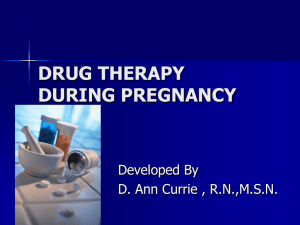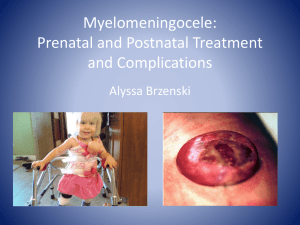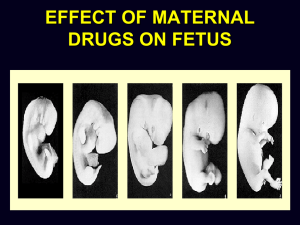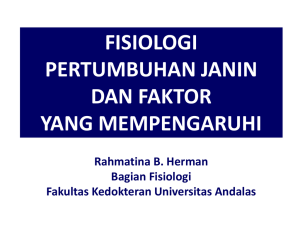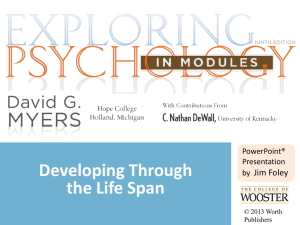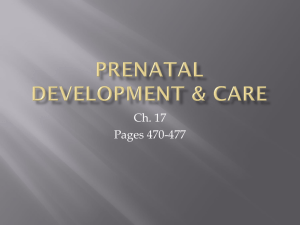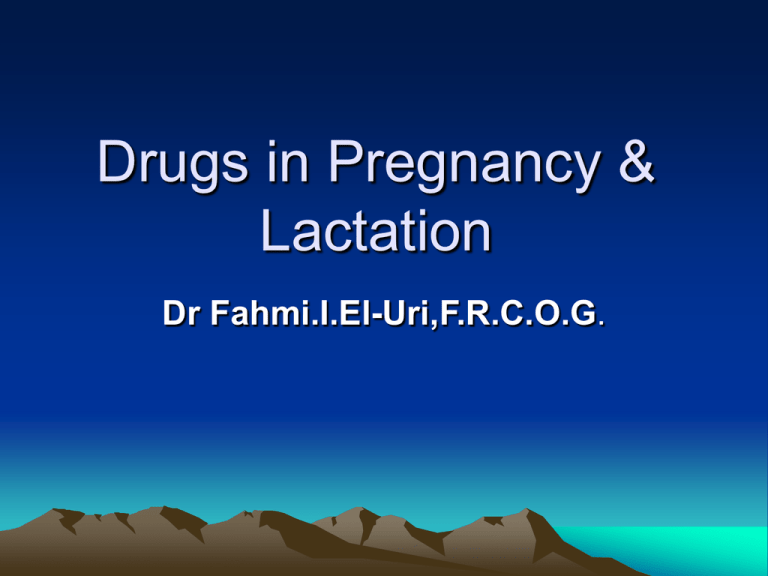
Drugs in Pregnancy &
Lactation
Dr Fahmi.I.El-Uri,F.R.C.O.G.
Plan of discussion.
•
•
•
•
•
•
•
Introduction
Drugs affecting the embryo
A- In the early days of conception
B-After the implantation
Drugs which may affect the fetus
Drugs acting on the neonate(lactation)
Conclusion
Introduction
• The great majority of drugs cross the
placenta by “Simple diffusion” from high to
low concentration
• Rate of transfer depends on the following:
• A- concentration gradient
• B-thickness &surface area of the
membrane
• C-diffusion constant=K
Diffusion constant=K
• Molecular Weight of the drug
i.e.M.W.<1500 pass ‘placental barrier” by
simple diffusion,e.g.Warfarin.
• M.W.>1500 doesn’t pass “placental barrier
e.g.Heparin.
Diffusion Constant =K
• K will depend on the configuration of the
molecule e.g. Immunoglobulin will pass its
M.W. 100,000 or more.
Continue
• Molecules not bound to protein are
available for transfer.
• Molecules highly soluble in fat & in
unionized state ll quickly pass to the fetus.
• Molecules low solubility in fat & in an
ionized state ll slowly pass to the fetus.
The Effect of a drug on ‘offspring :
• A-The dose absorbed by the mother.
• B-The period of gestation .
The period of gestation:
• In the early days of conception; before
implantation-NO TERATOGENICITY- Gregg
1940.The harmful drug ll kill the embryo or leave
it unharmful.
• After the implantation; drugs like THALIDOMIDE
may act as Teratogens.
• Congenital Malformation of ‘ embryo,occurs 20 50 days of gestation ,but from the 4th month no
teratogenic effect , but injury to fetal organs&
placenta may occur.
Drugs which may affect the
embryo:
• 1)Cytotoxic drugs can lead to teratogenic effects
& death.
• a-Anti-metabolites
e.g.Allopurinol,6mercaptopurine,methotrexate.
• B-Alkylating agents
e.g.Chlorambucil,Cyclophosphamide,
• Explanation: These drugs owe their therapeutic
action due to their ability to kill rapidly dividing
cells.These drugs shouldn’t be use unless the
pregnant woman is suffering from malignant
leukaemia or some form reticulosis( termination
of pregnancy is advised).
Continue
• Methotrexate : has been used in
therapeutic abortion & in ectopic
pregnancy.The incidence of fetal
abnormality is around 10%.
Continue
• 2) Thalidomide: was used to prevent
vomiting in 1968 but it caused fetal
anomalies ( phocomelia + amelia ).
• 3) Cortisone:large dose in pregnant
rabbits,mice,monkeys caused cleft
palate,hare lip.In human pregnant woman
trials showed no abnormalities.
Continue
• 4)Tolbutamide,Chlorpropamide:were
regarded with considerable suspicion in
the management of the pregnant diabetic
woman.No confirmation that these drugs
are teratogenic .
• 5)Nicotine:no teratognicity,but it causes
small for dates,increase in abortion rate
&incease in perinatal mortality(P.N.M.).
Continue
• 6)Salicylate:large dose in mice is
teratogenic or can lead to resorption of the
embryo.Na salicylate (acute rheumatic
fever),the dose used, wt for wt approaches
that which is teratogenic in pregnant
mice.A study from CANADA reported
premature closure of the ductus arteriosis,
pulmonary hypertension leading to blue
babies.
Continue
• 7)Phenothiazide,Ancoloxin,Metronidazole,
Cannabis,L.S.D. :
• All these drugs have been suspected at
one time & this was based on few
individual case reports but further
experience of these drugs didn’t suggest
that they are harmful in normal dose.
Summary of teratogenic effects:
• Lithium (cardiac e.g.ebstein’scomplex)<5%.
• Warfarin(chondrodysplasia punctate)1025%.
• Phenytoin(cranio facial/limb)2-26%.
• Valproate(CNS) 1-2%.
• Carbamazepine(CNS/LIMB/CARDIAC)0.636%.
Continue
• Primidone&Phenobarbitone(facial
cleft/cardiac) –unknown.
• Sex hormones(cardiac/limbs)-unknown.
• Danazol(Masculination)-unknnown
incidence
• Isotretinoin ie Roaccutane(CNS)high
incidence &the same for other retinoids.
Drugs which may affect the fetus:
• A number of drugs may cause ill-effects in ‘
developing fetus although they aren’t
teratogenic.
1) Anti-thyroid
drugs;(carbimazole,neomercazole,thiouracil);these drugs cross ‘ placenta,interfere with ‘
synthesis of ‘ thyroid hormone in ‘ fetal thyroid
gland causing compensatory overaction of ‘
pitiutary leading to fetal goitre which may cause
neonatal respiratory obstruction.
Continue
Lack of thyroid hormone ll cause fetal
cretinism& mental retardation.
If anti-thyroid drugs are used, they should be
combined with L-Thyroxine.
In the past Iodides were used in expectorant
mixtures & asthma powders , large doses
ll impair the inorganic binding of iodine in
the thyroid gland causing fetal goitre.
Continue:
Radio –Active Iodine ;shouldn’t be used in
pregnancy, because the fetal thyroid gland
ll be destroyed if Iodine 131 is ingested by
the mother.
2) Hypotensive Drugs :
• Beta-Blockers;(eg propanol=inderal,
atenalol=hypoten,tenormin).
These drugs may cause
hypotonia,hypoglycaemia& intrauterine
growth retardation of the fetus ,in addition
increase in P.N.M.due to placental
insufficiency.
Continue
• Reserpine=Adelphan, the fetus ll sufer of
marked lethergy,nasal blockage &
discharge leading to respiratory difficulty &
inspiratory costal retraction of the fetus.
• Methyldopa=Aldomet,is relatively
harmless,may cause +ve Coombs test in
the fetus.
Emergency Hypotensive:
• Hydralazine=Apresoline:causes decrease
of syst.BP without decrease renal flow,but
S.L.E. like picture in the treating mother.
• Dioxide=Hyperstat:causes mother
hyperglycaemia due to decrease insuline +
fetal alopcia.
• Nowadays we are treating PET by :
• Methyldopa,NIFEDIPINE(adalat),LABETA
TOL(trendate),& HYDRALLAZINE.
3)Drugs causing kernicterus&
jaundice.
The causitive drugs ll cause dissociation of the
bilirubin from its protective binding to serum
albumin in the fetus.The free bilirubin diffuse
readily into the CNS producing Kernicterus:eg
the following;
Sulphonamide(sulphafurazole),Long acting
Sulpha(sulphamethoxazole+trimethoprim=septri
n)
Salicylates,Phenylbutazone(butazolidin)
Phenothiazides + water soluble vit K(not used now
Vit K1 is ok- NO KERNICTERUS.
4)Antibiotic drugs:
• Tetracycline;after 4th month of pregnancy it
enters ‘ fetal circulation ,chelates with Ca
& deposites in teeth,bones,nails.When
‘teeth erupt in ‘ infant ,they are at 1st light
yellow & fluoresce in ultraviolat light & later
the colour fades gradually to a non
florescent brown, in addition to hypoplasia
of ‘ enemal leading to dental caries
Large doses may cause Acute Fatty Liver of
pregnancy.
Ampicillin& penicillin :safe
• Cephalosporins :safe
• Chloramphenicol :B.M. depression in ‘
mother & very dangerous to premature
neonate “Grey Syndrome.
• Metronidazole:not teratogenic in man ,but
is teratogenic in rats its not used in
pregnancy in USA,but it is used in routine
dose in 2nd & 3rd trimester in UK.
Anti-TB drugs:
Isoniazid,PAS,Streptomycin,Rifampicin,&
Ethambutol.
The risk of fetal ototoxicity with strept,is 311%.
Rifamp, causes 3% malformation rate (toxic
labyrinthine damage).
Aminoglycoside:
Streptomycin, risk of ototoxicity in the fetus
as it affects the auditory components of ‘
8th cranial nerve , this is rare in normal
dose, but consider this risk before
prescribing .
Nitrofuratin:
This drug may be used to treat UTI.
It may produce neonatal haemolysis
because it acts on neonatal RBCs which is
deficient in Glutathione & Glucose 6
phosphatase dehydrogenase.
5) Drugs causing fetal or neonatal
haemorrhage:
Warfarin, Phenindione( small M.W.) may cause
retroplacental He or cerebral He in ‘ fetus if ‘
level of prothrombin in ‘blood is brought too
low.In 5% of cases facial & CNS anomalies may
occur.
Heparin (large M.W.) doesn’t pass to the fetus.
Thiazides diuretics used in PET to produce fluid
loss may cause thrombocytopenic purpura in the
neonate ( the risk is small).
6) Oral Hypoglycaemic agents:
Long acting agents “Chlorpropamid” pass to
the fetus from ‘ mother causing severe &
prolonged neonatal hypoglycaemia &
neonatal death.
7) Anti-Convulsant drugs:
Phenobarbitone,Phenytoin,Primidone ;
Retrospective study suggested that cleft lip
& palate may occur in the fetus, but
prospective study of 16 neonates of
mother on anti-convulsant drugs showed
that 7neonates had severe coagulation
defects similar to vitamin K deficiency.
Prophylactic RX of ‘ mother with vit,K may
prevent this risk.
8) Sex Hormones :
• Androgens & progestogens; have been used in ‘
management of threatened abortion ,causing
masculinization of female fetus with clitorial
enlargement & labial fusion.
• Oestrogens carry the risk of adenosis or
adenocarcinoma of ‘ vagina of the female
offspring 15-20 years later, in addition
hypospadias in ‘ sons of pregnant women
treated on Diethyl still-boestrol.
• O.C.pills , risk of fetal limb reduction & cardiac
abnormality.
Vitamin A (retinoids):
• CNS malformation (5-6000iu / day );in
addition anomalies in the eye,palate & urogenital tract occurred in experimental
animals.
Folic acid tablets:
• Prospective studies showed a decrease in
the incidence of CNS anomalies in women
taking folic tablets.
Adverse effects of drugs on fetal
growth & development :
• Drugs used to treat hyperthyroidism can cause
fetal & neonatal hypothyroidism.
• Tetracycline antibiotics may inhibit growth of fetal
bones &teeth.
• Aminoglycoside antibiotics can cause 8th nerve
damage.
• Drugs such as
opiates,benzodiazepines,dextropropoxyphene
,can lead to fetal drug dependence & withdrawal
symptoms if taken regularly during pregnancy.
Continue :
• An important structural defect that may
occur in later pregnancy is premature
closure of ‘ ductus arteriosus; this results
from taking potent prostaglandin
synthetase inhibitors, such as
indomethacin.
• ACE inhibitors (captopril) may reduce fetal
& neonatal blood pressure & cause renal
impairment.
Drugs acting on the neonate:
A number of drugs when taken by ‘ mother
are by her milk & therefore pass to’
infant.
Most of these drugs are secreted in such
small amounts that is seldom necessary
to discontinue breast feeding.
a) iodide, sulphonamides,antihistamines.
b) Bromides;lead to skin eruption in
‘neonate
Continue;
c)Diazepam, chlordiazepoxide, the level of these
drugs in ‘ milk is 1/8 that in ‘ maternal blood,if
given in large doses ,neonatal lethergy &
hypotonia.
d) Phenobarbitone ;secreted in sufficient amounts
in ‘ milk & makes ‘ infant drawzy ,
The rate of elimination of ‘ drug by ‘neonate is
slow,also it induces ‘ glycuronil transferase
enzyme & so it is used to decrease ‘ free
bilirubin.It is similar to ‘ withdrawal symptoms of ‘
Heroin addicted mother.
Continue;
e)Two groups of drugs; lead to discontinue Breast
feeding.
-Anti-thyroid drugs:carbamazole, thiouracil.
-Anti-coagulants : warfarin, phenindone.
N.B.Heparin ,is safe,doesn’t cross to ‘milk.
f)Chloramphenicol ,( B.M. suppression).
g)Tetracyclines:(discoloured teeth).
h)Sulphonamides:(kernicterus ,haemolysis
inG6PD deficiency ).
Continue;
i)Isoniazid;causes neurological
complications(convulsions, neuropathy).
j) Aspirin; possible risk of Reye’s syndrome.
Maternal drug addiction & ‘neonate
Heroin ,2/3 of ‘ infants will have withdrawal
symptoms within 24 hours.Light B.W., low
Apgar score ,irritability ,tremors,
twitching,piercing cry,RDS,frequent
yawning & sneezing.
CONCLUSION:
Our knowledge of the drugs on the human
embryo is extremely small & at the present
time it’s the duty of all doctors to avoid
prescribing any drugs in the 1st trimester of
pregnancy unless its absolutely indicated.



